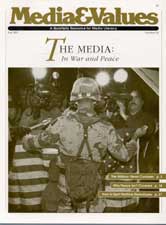Gulf War: The More We Watched, the Less We Knew
|
This article originally appeared in Issue# 56
|
Despite wall to wall coverage of 'Desert Storm', viewers don't get the big picture.
What would happen if they held a war and nobody watched?
As Media&Values staff members joined the millions of TV watchers glued to their television sets in January, we began asking ourselves that question. As the hours of televised bombardments, Scud missile attacks and, ultimately, victory parades wound on, we became more and more aware of the media's role in forming not just issues of war and peace, but our view of them.
In fact, according to the responses of selected Denver residents to a poll conducted by University of Massachusetts/Amherst researchers, media usage played a big role in influencing wartime opinions. Researchers found that heavy TV watchers were more likely to support the war. They were also less (not more) likely to be well informed about its causes and consequences. Put simply, researchers concluded that the more TV people watched, the less they knew. Throughout this issue, a number of knowledgeable people voice various opinions about the media's role in this and all wars. But the war is over. Why are we talking about it now, months later?
Because, unfortunately, conflict hasn't disappeared from the world with the cease-fire. And, understanding of the media's role as a player in world events becomes more and more crucial as we face the post-Cold War world. On the surface, this issue is about the Persian Gulf War. It questions many aspects of the news and media coverage of that conflict, including:
- governmental use of public relations techniques to mold public opinion;
- media submission to the allure of flashy technology while ignoring its impact on humankind;
- the stifling of alternative views resulting from limited or unbalanced coverage by critics of the war;
- dehumanization and demonization of a stereotyped enemy.
Researchers found that heavy TV watchers were more likely to support the war. They were also less likely to be well informed about its causes and consequences.
Still, Gulf War TV coverage provided one of the best examples yet of the misleading selectivity of instant satellite feeds and the ability of authorities (in this case the military) to command a platform. But the view from the platform is the real problem. What lessons, then, can we learn from this issue? As author and philosopher Sam Keen points out on page 18, negative images fabricating a distorted view of an enemy make belligerence possible. For decades, the development of propaganda has turned the job of creating enemies over to the media. But this process isn't limited to war.
Race riots, urban conflicts, even political campaigns, provide day-to-day examples of public relations distortion and stereotyping that polarize society in the guise of information or entertainment. Readers who use the activity sheet on pages 21-22 will gain a new perspective on the bias hidden in seemingly ordinary news stories. Groups and classes that organize around the accompanying Media Literacy Workshop Kit ™ on Images of Conflict will sharpen their skills in reading the media images that so powerfully influence our perceptions. Readers and viewers with this understanding have taken a crucial step toward demanding more of their media, whether broadcast or print.
Of course, genuine problems and conflicts will continue to exist in the world. The ability to distinguish between reality and media distortions will not eliminate them, but it can help us recognize them when we see them. Only then might we find that somebody has taken a poll with a startling conclusion: The more television viewers watched, the more they knew.
NOTE:
The research study noted in this article from the University of Massachusetts is The Gulf War: A Study of the Media, Public Opinion and Public Knowledge by Justin Lewis, Sut Jhally and Michael Morgan.



